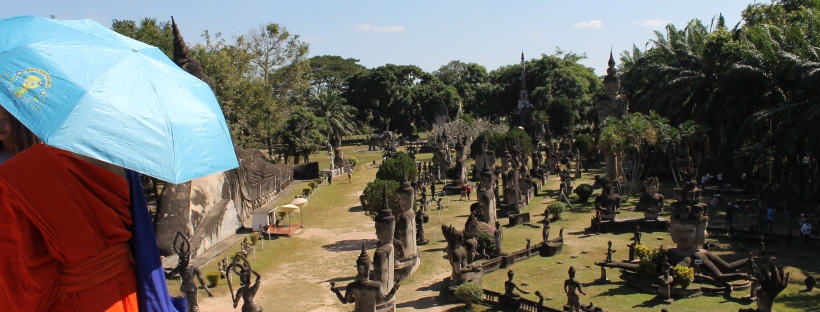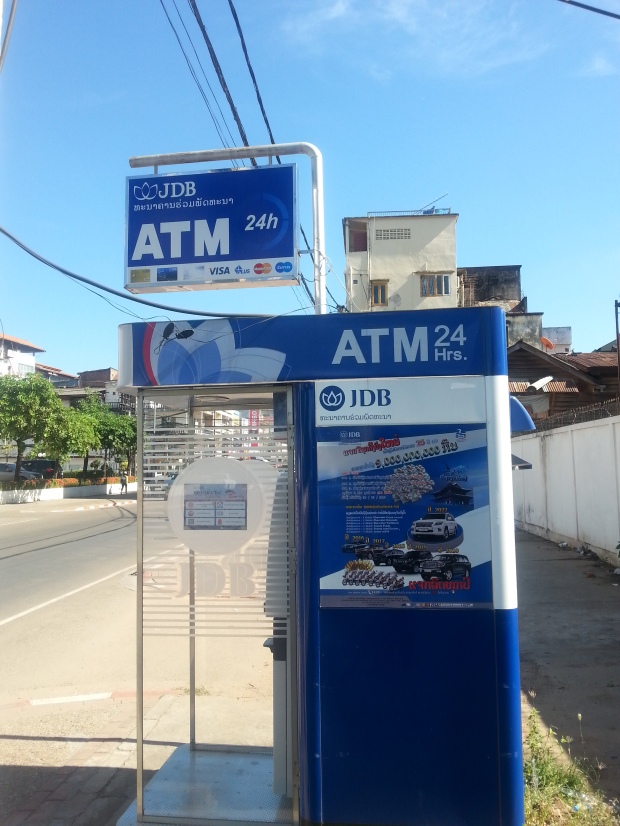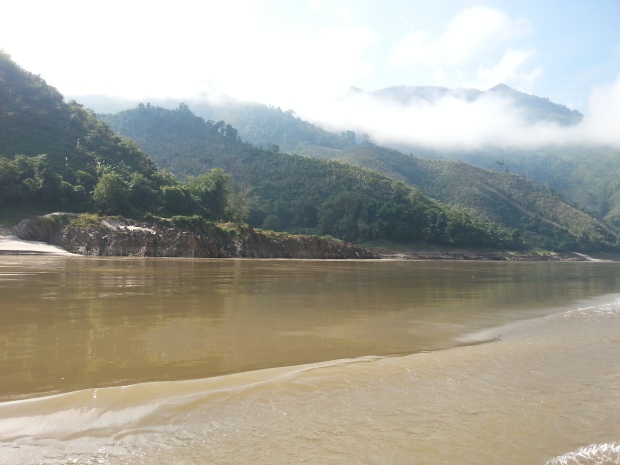The bus from Hanoi to Vientiane, often named the “bus from Hell”, is known by many travelers as one of the worst bus rides in South East Asia. Wanting to get from Hanoi, Vietnam to Vientiane, Laos as cheaply as possible, I convinced Dahn that the internet likes to overreact. That the “bus from Hell” is simply a made up term by frustrated travelers who always want to be in maximum comfort. Travelers who think everything is about them and do not consider others. Well, as I soon learned, either I was one of those travelers now or it is actually the bus from Hell.
Having convinced Dahn, the next step was to buy the tickets for the bus. You can either go to the bus station in Hanoi that is 30 mins away from the old center and buy the tickets for between 450 000 VND to 500 000 VND or buy from an agency or hotel for around 650 000 VND. We decided that getting the transport to the bus station would probably come to around the same price and be a lot of hassle. We therefore went to the trusted Sinh Cafe Tourist agency to buy our ticket and hoped this would assure us good seats. The agent confirmed that we would have middle of the bus seats on the lower bunk beds. Dahn began to feel better as everything seemed really convincing and seemed to be going well. That lasted only until we got out of the office.
We realized that we went to a copycat Sinh Cafe (See our blog post about 11 Things to know about Vietnam). Our hearts dropped as we ran inside to get a refund. The agent refused and insisted that he is selling a quality product. After some polite arguing we left with fear in our hearts and empty wallets containing only some sketchy looking bus tickets.
The next day we did not feel any better when the bus that was supposed to pick us up at 5 PM did not show up until 6 PM. We then were driven away to the bus station and due to heavy traffic we arrived at 7 PM. The departure time of our bus. That did not stop our guide from taking his time while handing us our real bus tickets. After confirming with him that we had reserved middle of the bus seats on lower bunk beds he gave us our tickets and we headed out in the rain to board our bus. Luckily it was still there waiting for our group and some other Vietnamese.

Wet Bus station
Under the rain, we ran to and attempted to board the bus. For some reason, the bus driver refused to let us on. The bus was already half full with Vietnamese clients, why were we not allowed? We then ask a Vietnamese young lady who had a British boyfriend to ask the bus driver why we could not get on. He told her that she could board now, that he was letting the Vietnamese clients board first. Wet and confused, we watched and waited another 10 minutes in the rain until the last Vietnamese client arrived and we were then allowed to board.
We boarded the bus expecting to find our seats in the middle of the bus on the lower bunk beds. They were all occupied already. When we finally found our seat, it was in the back of the bus as the internet told us it would be. All foreigners were at the back of the bus as expected. Knowing that arguing was futile, we sat in our capsule like seats and were happy that at least there was no luggage beside us or sleeping people in the lanes like the internet had told us. That was true, for the first few hours.
As the night go darker, the bus stopped more and more picking up people from the side of the road. The already full bus got fuller and fuller with people laying in the allies as predicted by the internet. The pile of sometimes stinky luggage grew bigger and bigger in the back of the bus. So much so that I could barely get out of my seat by now. Luckily for me however, the person laying in the ally beside me was a small Vietnamese boy.
This young boy was curious about me and especially my smartphone. I spent a good time of the bus ride showing him pictures, videos and games on my smartphone. It not only helped pass the time but it also brought my spirits up a bit. A few hours of gaming later, the boy and I fell asleep and spent a rather usual night bus ride. In and out of sleep, cold and uncomfortable but not bad. We then arrived at the Laos – Vietnam border in the early morning before the border actually opened. We got a good two hours or so of motionless sleep which was nice. At around 7 or 8 AM the gates opened and we got off the bus to stamp-out of Vietnam. Unsurprisingly there was an unannounced 20 000 Dong exit fee to pay, so make sure to have at least that much left in VND. After we were cleared, we were told by the bus driver that we had to walk to the Laos border. Arguing being useless, all foreigners walked in the morning misty rain for a kilometer up and down a muddy road while the Vietnamese people were comfortably dry inside the bus.
The British guy with a Vietnamese girlfriend realized mid-way while speaking with other foreigners that the reason we were supposed to walk and not the Vietnamese was because we needed to get an entry-visa. Having prepared his visa ahead of time he ran back to the bus to not get too wet. While we were filling our Visa on entry form that cost us 43 $ USD because we are Canadians (list of visa costs), the British guy came into the Visa office out of breath and dripping wet. He had been refused access to the bus and had to run back! I could not believe it. He just waited there wet and shivering while we got our visas.
After everybody got their visas, we crossed the Laos gate and were officially in Laos! We were excited and sad of leaving Vietnam but could not wait to discover Laos. We now were expecting a smooth 5-6 hours bus ride arriving in Vientiane in time for dinner. Obviously, that was not about to happen.
A few hours into the beautiful scenery of Laos, our bus stopped mid-way a hill. Not sure what had happened, we waited in the warming bus for about 30 minutes until people started to get out of the bus and saw the workers pouring dozens of water bottles in the engine cooler. We waited another 20 minutes for the bus to cool down as it seemed to have overheated due to a leak in the engine cooling system. We were then on our way! For another 200 meters until the bus came to a halt again…
We were now only 5 hours away from Vientiane but had to wait for the bus to get fixed. The workers who did not speak Vietnamese did not even try to communicate with the foreigners but thanks to the British guy’s girlfriend, we found out that the bus needed to be fixed with a part that would have to be driven over from Vientiane. Meaning we would have to wait at least 5 hours plus the time to fix the bus. Thankfully, for some, a bus stopped beside us and started to take people for around 10$ USD in KIP. Problems was, us and many others did not have any KIP yet. Thus, we had to wait. And wait we did.
The bus was not fixed until 7 PM. The bus broke down around 11 AM… It was a long wait for sure. Thankfully however, we had made friends with the British guy and his Vietnamese girlfriend. We got to know a lot about them, Britain and Vietnam. While speaking with them, we also learned that the bus driver and his assistant were laughing at the foreigners at the border crossing and that they actually enjoyed seeing us upset. We were quite shocked and angry but not surprised, not at that point.
5 hours later, we made it alive in Vientiane, frustrated but alive. Obviously we did not get any type of apology or compensation and we had to pay inflated prices for the tuk tuks in Vientiane as it was pass the curfew time in Laos. The bus station being located quite far from the old town, expect to pay up to 70 000 KIP per person. We had gotten it down to 35 000 KIP each because we walked to the street and we were four people.
So all of this being said, I can’t honestly call it a “bus from Hell”. Will it be an unpleasant journey? Yes. Will you feel like you are not equal to Vietnamese people? Yes. Will you get frustrated but won’t be able to express your feelings? Yes, or else you will get double the unpleasantness. Will you momentarily feel like all of Vietnam is a horrible place? Yes probably, for a few hours after you get off the bus. But as time goes by, you will miss Vietnam and its people. And you will not have regretted having taken the “bus from Hell”. We made some new friends and got to see some amazing scenery. We got to experience new feelings we never had before and we were maybe even humbled by the “bus from Hell”. If you need to travel from Hanoi to Vientiane, do take the bus. You won’t be visiting Hell. But you might just feel like your knocking on the first gate…

Dahn staying happy by showing her unhappiness
Anyway, Good luck and good travels! It’s really not that bad, Dahn always like to remind me how dramatic I am so no worries!






































































